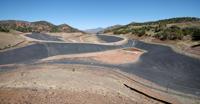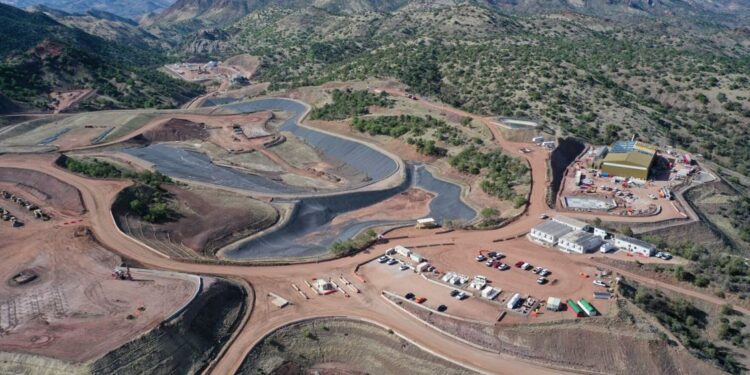A 2023 aerial image shows Australian company South32’s proposed Hermosa critical minerals mine in the Patagonia Mountains, 75 miles southeast of Tucson. Â
Russ McSpadden, Center for Biological Diversity
South32 officials said they are still studying when — or whether — to ramp up manganese mining and production. As part of that process, they are talking to battery companies, automakers and other potential customers to determine demand for their product.
If South32 decides to move ahead, the company has said it wants to build its production facility somewhere in Southern Arizona, preferably in Santa Cruz County.
But some residents and environmental groups are already raising health and safety concerns over the trucking and processing of manganese, which in high levels is toxic to humans.
On Sept. 12, a coalition of conservation groups filed a legal petition challenging the air quality permit that was issued to the Hermosa project by the Arizona Department of Environmental Quality in August.
The groups want the federal Environmental Protection Agency to overturn the permit, which they say violates clean air laws and regulations.
The petition was filed by the Center for Biological Diversity, Patagonia Area Resource Alliance, Arizona Mining Reform Coalition, Calabasas Alliance, Friends of the Santa Cruz River and the Grand Canyon Chapter of the Sierra Club.
“South32’s Hermosa mine should never have been issued an air pollution permit,” said Carolyn Shafer with the Patagonia Area Resource Alliance. “The EPA is our last chance for reversing this disastrous decision and protecting the health and wellbeing of all creatures that live in and near the Patagonias.”
Added Jeremy Nichols, senior advocate for the Tucson-based Center for Biological Diversity: “This is about standing up to the Arizona Department of Environmental Quality’s blatant attempt to give the mining industry a free pass to pollute.”

The liner for a dry-stack tailings pile can be seen from the overlook at the South32 Hermosa mining project site in the Patagonia Mountains.
Grace Trejo, Arizona Daily Star
Under review
For their part, South32 officials are promising to develop a “different kind of mine” powered by renewable energy and governed by strict environmental safeguards. They insist the operation will be developed using “state-of-the-art technology and industry best practices” to protect the safety of employees and the surrounding community. That includes conducting a “baseline assessment of existing community exposure” to manganese and other pollutants, company officials said.
The project is in the midst of an environmental review by the U.S. Forest Service.
The review is currently slated for completion in mid-2026 and will focus on South32’s plans to mine beneath Coronado National Forest and build support facilities on public land surrounding the company’s private tract. The proposed facilities on forest land include a second tailings pile and at least two infiltration basins for returning treated groundwater back into the local aquifer.
The Forest Service is also reviewing South32’s request to build a new 138-kilovolt transmission line to deliver power to the mine and an 8-mile main access road through nearby Flux Canyon that would link the site to Arizona Route 82 near the turn-off for Patagonia Lake.
The $2.16 billion the company plans to spend on Hermosa has been called the single largest private investment in Southern Arizona history.
South32 is promising to create up to 900 jobs and nearly double the tax base in Santa Cruz County, where company officials said the unemployment rate is twice the state average and roughly 25% of residents live below the poverty line.
Hermosa president Risner said the funding from the Energy Department should certainly help with all that.
“This grant highlights how important Hermosa and Santa Cruz County are to boosting America’s energy security in a way that creates economic opportunities across southern Arizona,” he said.
Source link : http://www.bing.com/news/apiclick.aspx?ref=FexRss&aid=&tid=66ee136267624ae187fd407eb8aa7f12&url=https%3A%2F%2Ftucson.com%2Fnews%2Flocal%2Fsubscriber%2Fhermosa-mine-federal-grant-manganese-arizona-electric-vehicle-batteries%2Farticle_293b46a0-7774-11ef-8530-d7e5f81ba143.html&c=2095865150433472208&mkt=en-us
Author :
Publish date : 2024-09-20 11:05:00
Copyright for syndicated content belongs to the linked Source.












